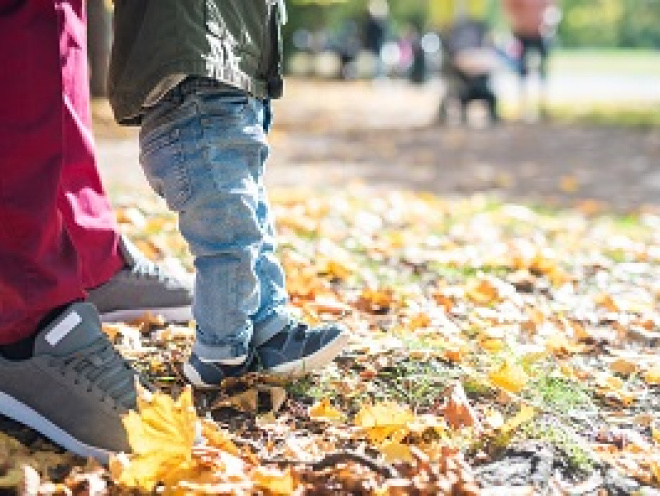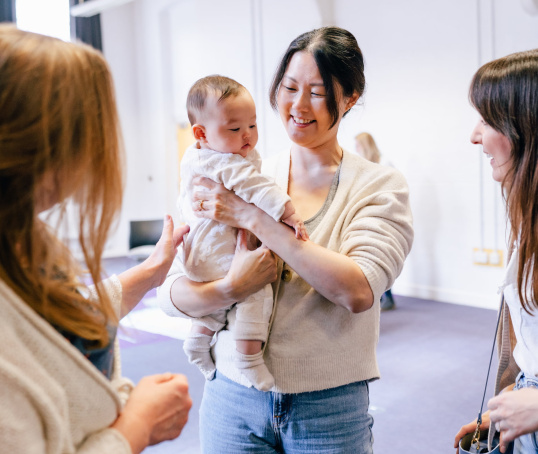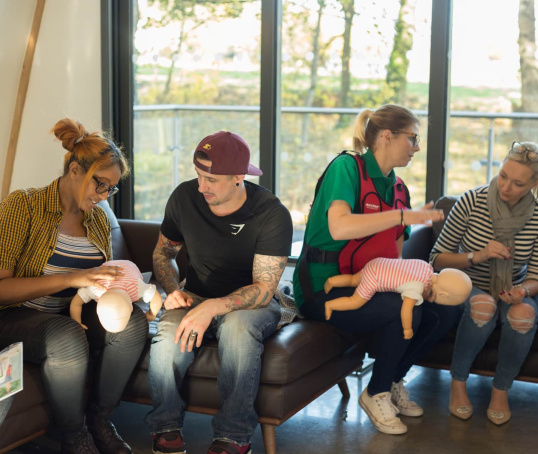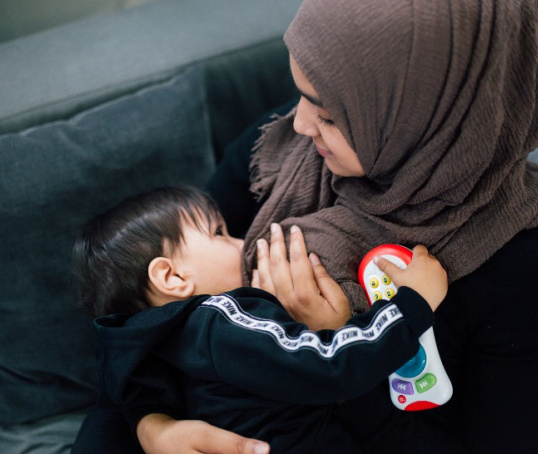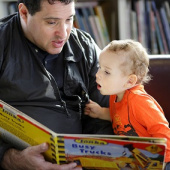This article explores that magical moment of buying your little one’s first shoes, when to start thinking about buying them and what to look for.
There’s a lot going on beneath the surface of those cute baby feet. Each of your baby’s feet starts with 22 partially developed bones, which will grow to around 45 by the time they’re five years old (The Children’s Foot Health Register, 2018a). Those will have fused to create 26 fully-formed bones by the time they’re an adult.
"It’s those first few months and years that are crucial for the development of your child’s feet. So it’s a good idea to get clued up on the right footwear and when to get it."
From cruising to first steps
If you’re starting to think about first shoes, chances are that your baby’s begun to master the art of cruising. This usually starts between 10 and 18 months (Oxford Health NHS Foundation Trust, 2017). Cruising happens between crawling and walking, where your little one pulls themselves up onto everything and starts to slide their way along with their hands and feet.
But don’t be tempted to rush out to the shoe shop just yet – your child doesn’t need shoes until they’re walking on their own (NHS, 2018). At this stage, going barefoot is best as it allows them to get used to taking steps naturally. Shoes might just get in the way, or worse may hinder their development if they’re not the right fit (Oxford Health NHS Foundation Trust, 2017).
No rush to wear shoes
At some point during this time, that magical moment will arrive – your child’s very first independent steps. There’s no need to rush them; all children will develop at their own pace. But once they’ve reached this stage, the time has come for that next landmark – their first pair of shoes.
How necessary they are does slightly depend on the weather. If it’s high summer, your child might last a few more weeks with bare feet or socks in the garden or local park. If it’s drizzle season, or autumn leaves are squelching underfoot, you might want to keep their feet protected from the elements sooner. Use a common sense approach.
Do note though that even once they’re proud shoe owners, they don’t need to wear them all the time. Only put them on when they are walking outside, at least to begin with (NHS, 2018).
A fitting occasion
Shopping for first shoes is one thing that can’t be done online. Find out where your nearest trusted shoe shop is using the Children’s Foot Health Register and take your little one for a fitting. You’ll probably want to take lots of pics and a video or two to save the moment.
Do you remember those big, scary shoe-sizing contraptions from when you had shoes fitted as a child? Well, thankfully, they are no more. Your fitter will probably use a hand-held mini foot gauge and measure width and length. And because we’re not perfectly symmetrical beings, it’s entirely normal for one foot to be bigger than the other, so the size will be taken based on the larger foot. Once the measurements are complete, you’ll have your child’s foot size and it’s time to get shopping.
Getting the basics right
Before you start thinking colours and styles, it’s good to know the basic features to look out for. This will make sure your toddler’s first shoes allow them to grow normally and comfortably. The College of Podiatry has this handy checklist:
- Look for close-cropped soles to prevent tripping.
- Make sure there’s room for movement and growth built into the shoe.
- Try to get shoes with soft leather uppers for cool, comfortable feet.
- Choose shoes with lightweight, flexible soles to aid walking development. Most brands have pre-walkers, which are super-soft and actually fine for the first few walking months (according to parents we speak to).
- Look for fully adjustable fastenings.
- Try to find shoes with padded ankles for protection and support. Again, a common sense approach here is key. Some parents tell us it is obvious which styles their baby is most comfortable in when they try on a few. Some like high ankle support, others like them below the ankle.
(College of Podiatry, 2018)
If all that sounds like quite a lot to think about, don’t worry, your fitter will be on hand to help too. Now for the fun bit.
Choices, choices…
With those guidelines in mind, you have a whole range of choice. Your main consideration will likely be the weather. Leather uppers are great, but canvas or cotton is fine too as these are also natural (NHS, 2018). The trouble with synthetic or plastic uppers is that they don’t let your toddler’s feet breathe, and their feet can become sweaty and rub (NHS, 2018). The same goes for socks – choose a natural fibre, like cotton (NHS, 2018).
As with coats and outer trousers, Velcro is your friend – easy-to-use fastenings will also encourage your toddler to put their shoes on and take them off themselves when they’re ready. Although if they are likely to just keep taking them off, consider buckles or laces. All three are good options as they hold the foot in place and prevent it slipping forwards, which can squish tiny toes (NHS, 2018).
Look for well-known brands you can trust when selecting your toddler’s first pair of shoes. Leather shoes take on the shape of the foot, so you should never hand them down to another child for whom that shape may be quite unsuitable. That’s because it might harm their foot development (IOCP, 2018).
Once you’ve taken the plunge with a first shoe purchase, you’ll realise just how quickly your toddler’s feet grow. Shoe buying can start to become an expensive pastime. Nearly-new options for toddler clothes are always a good idea, but with shoes, unfortunately, it is worth buying new, as they quickly mould around the wearer’s foot.
The much less heralded second pair, and third, and fourth…
Your toddler’s shoe should always have space at the front to allow those tiny toes to wiggle and spread so check that they have this (Oxford Health NHS Foundation Trust, 2017). A typical toddler will need a new pair of shoes every two to three months until they’re two and a half; after that their rate of growth slows down a little (Wenger et al, 1983).
Children’s feet are very flexible and not particularly sensitive, so they seldom complain of areas of pressure or friction (The Children’s Health Fit Register, 2018b). That means you’ll need to check their shoes fit regularly (IOCP, 2018).
It’s also important to get your child’s shoes professionally checked for correct fit more often than you might have thought. This should be done every four to six weeks for children up to three years old, every six to eight weeks from three to four years, and every 10 to 12 weeks thereafter (The Children’s Health Fit Register, 2018c).
Do keep checking your child’s shoes fit as children’s feet grow super fast until they’re five and their bones need to grow straight (NHS, 2018). If they’re cramped by tight fitting shoes or socks, your baby’s soft toe bones won’t be able to grow properly (NHS, 2018).
Your baby’s feet will be growing up quick just like the rest of them, so it’s important to make sure their second, third and fourth pair of shoes fit just as well as the first. Happy shopping.
This page was last reviewed in November 2018.
Further information
Our support line offers practical and emotional support with feeding your baby and general enquiries for parents, members and volunteers: 0300 330 0700.
We also offer antenatal courses which are a great way to find out more about birth, labour and life with a new baby.
You might find attending one of our NCT New Baby courses helpful as they give you the opportunity to explore different approaches to important parenting issues with a qualified group leader and other new parents in your area.
Make friends with other parents-to-be and new parents in your local area for support and friendship by seeing what NCT activities are happening nearby.
For more information about caring for your toddler’s feet and footwear, take a look at these websites:
College of Podiatry. (2018) Baby first shoes. Available at: https://cop.org.uk/foot-health/advice-for-parents/baby-first-shoes/ [Accessed 13th October 2018].
NHS (2018) Leg and foot problems in children: Choosing first shoes. Available at: https://www.nhs.uk/conditions/pregnancy-and-baby/leg-and-foot-problems/ [Accessed 16th October 2018].
Oxford Health NHS Foundation Trust. (2017) Children’s foot care. Available at:
https://www.oxfordhealth.nhs.uk/podiatry/foot-health/childrens-foot-car… [Accessed 13th October 2018]
The Children’s Health Foot Register. (2018a) Putting children’s foot health first. Available at: http://www.fitkidsshoes.org/ [Accessed 13th October 2018].
The Children’s Health Foot Register. (2018b) New parents tips. Available at: http://www.fitkidsshoes.org/new-parent-tips/ [Accessed 1st November 2018].
The Children’s Health Foot Register. (2018c) Foot health leaflet. Available at: http://www.fitkidsshoes.org/wp-content/uploads/2018/01/FOOTHEALTH-LEAFLETS.pdf [Accessed 1st November 2018].
The Institute of Chiropodists and Podiatrists. (2018) Foot care for babies and young children. Available at: https://iocp.org.uk/footcare-advice/foot-care-babies-small-children/ [Accessed 1st November 2018].
Wenger DR, Mauldin D, Morgan D, Sobol MG, Pennebaker M, Thaler R. (1983) Foot growth rate in children age one to six years. Foot Ankle. 3(4):207-210.
